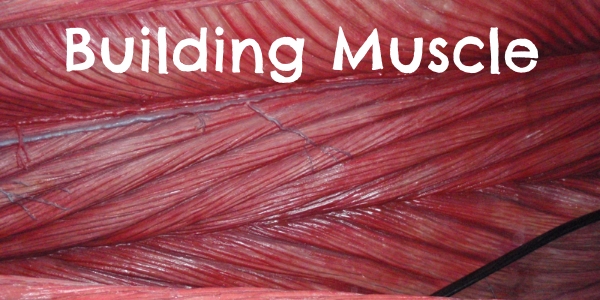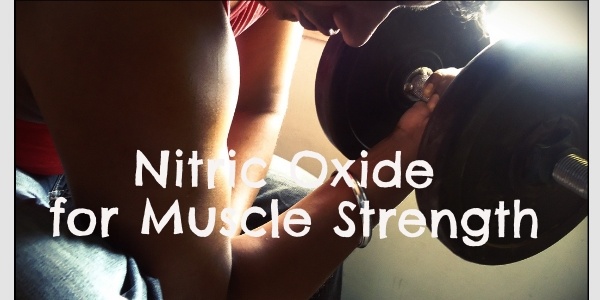
By Gene Bruno, MS, MHS – Dean of Academics, Huntington College of Health Sciences
Every bodybuilder knows the value and necessity of protein for supporting muscular...
By Gene Bruno, MHS

One of the latest categories of dietary supplements for athletes is nitric oxide (NO) boosters. In short, the concept is that nitric oxide helps regulate and direct muscle physiology by stimulating vasodilatation, which results in increased blood flow to working muscles. In turn, this leads to increased oxygen transport, delivery of nutrients to skeletal muscle, a reduction in blood pressure, helping to promote the repair of muscle fibers, and improvements in lactic acid clearance. So how does one boost NO levels?
The amino acid l-arginine is the answer. The main importance of l-arginine is considered to be its role as a precursor (building material) for the synthesis of NO.1 Supplemental sources of l-arginine are thought to augment nitric oxide production2 , with the result being a measurable increase in blood flow3 (i.e., vasodilatation). The idea is that the beneficial results of this vasodilatation for athletes include increased oxygen transport, delivery of nutrients to skeletal muscle, muscle fiber repair, and improved endurance.
Thus far, dietary supplement products that are touted to boost NO generally include arginine alphaketoglutarate (A-AKG) and/or arginineketoisocaproate (A-KIC) as sources of l-arginine. Futhermore, these products are generally marketed to bodybuilders. This gives rise to the question, “Do these NO products really have any benefit for bodybuilders?”
Honestly, I don’t know. At least I haven’t seen any studies conducted on bodybuilders (or any athletes) using l-arginine, A-AKG & A-KIC to boost NO levels, and promote muscle repair or endurance. However, the model upon which these products are based makes metabolic sense. Furthermore, if it does work then the primary benefit may turn out to be improved lactic acid clearance.
Any athlete can tell you that when lactic acid levels reach a critical level, muscle failure sets in, cutting your exercise session short and/or reducing your performance. Now consider that increased levels of lactic acid are present when oxygen delivery and arterial and venous oxygen contents are low.4 Furthermore, consider that improvements in NO metabolism resulted in improved lactic acid clearance.5 Of course this makes sense since NO improves blood flow, and improve blood flow brings fresh oxygen to augment lactic acid clearance. Theoretically an NO boosting supplement may help to do just that. As any athlete will acknowledge, an improvement in lactic acid clearance means an improvement in endurance.
In any case, AKG and KIC each have benefits independent of l-arginine and NO boosting. For example, in animal research AKG has been shown to significantly improve endurance.6 Also, human research has shown that KIC has nitrogen sparing effects7 , helping to inhibit the breakdown of muscle protein.8 9 This anti-catabolic effect may mean that less muscle tissue is damaged, allowing for a longer exercise session and quicker recovery. Furthermore, research has also indicated that AKG decreases lactic acid in cell mitochondria by increasing levels of oxygen uptake.10
Of course NO boosters are formulated to be used prior to exercise, which makes sense since increased blood flow during exercise is likely to provide performance enhancing results. However, there is one serious limitation. The key time for muscular repair is during sleep, and NO levels decline at night.
This means that NO’s potential benefits of helping to promote muscle repair will not take place at the time when muscle is primarily repaired.
Now you may think, “No problem, I’ll just take my NOX2 before I go to bed too.” The problem with doing this is that by supplementing with just arginine a second time during the day, you may cause a decline in endogenously (in the human body) produced arginine. This would really be counterproductive to the goal of increasing NO. This is a potential limitation of NO boosters. However, there may be a solution to this limitation.
The solution may be to use the amino acid citrulline in addition to A-AKG and A-KIC. Citrulline is actually a precursor to arginine. It is found primarily in the liver and is a major component of the urea cycle. Therapeutically it is used for the detoxification of ammonia, a byproduct of protein breakdown, and in the treatment of fatigue. In addition, at least one study has shown that citrulline significantly improved aerobic performance in athletes.11
The cool thing is that citrulline has the ability to increase plasma levels of arginine endogenously (in the human body).12 And what is really so exciting about citrulline is that it seems to increase plasma arginine levels better than taking the amino acid arginine itself. 13 This is the basis to the use of citrulline for increasing NO.
By including citrulline, the benefits of NO may be extended into the night, which means a potential improvement in muscle repair and subsequent muscle growth---and this can occur without causing a decline in endogenously produced arginine.
Although the NO promoting effects of A-AKG, AKIC and citrulline supplements require research to firmly verify their benefits, there is great potential for bodybuilders and endurance athletes. That potential includes increased blood flow, increased oxygen transport, delivery of nutrients to skeletal muscle, helping to generate growth of new muscle fiber, and improvements in lactic acid clearance.
Smart Supplementation™ is a free series of educational literature created by Huntington College of Health Sciences (HCHS) as a public service. Although copyrighted, it may be freely photocopied and distributed, but may not be altered in any way. Smart Supplementation™ is not intended as medical advice. For diagnosis and treatment of any medical condition, consult your physician.
1 Tapiero H, Mathe G, Couvreur P, et al. I. Arginine. Biomedicine & pharmacotherapy = Biomedecine & pharmacotherapie (France) 2002; 56(9):439-45. 2 Nonami Y. The role of nitric oxide in cardiac surgery. Surgery today (JAPAN) 1997; 27(7):583-92. 3 Cheng JW, Baldwin SN, Balwin SN. L-arginine in the management of cardiovascular diseases. Annals of pharmacotherapy 2001; 35(6):755-64. 4 Chiang BB, Stevens K, Etoch SW, et al. Blood lactic acid levels after artificial heart implantation. ASAIO journal 2001; 47 (6):683- 5. 5 Matejovic M, Radermacher P, Tugtekin I, et al. Effects of selective iNOS inhibition on gut and liver O2-exchange and energy metabolism during hyperdynamic porcine endotoxemia. Shock 2001; 16(3):203-10. 6 Kurhaliuk NM. [The effect of sodium alpha-ketoglutarate on the physical load endurance of rats with different resistances to hypoxia] Vplyv al'fa-ketohlutaratu natriiu na vytryvalist' do fizychnoho navantazhennia u shchuriv z riznoiu rezystentnist' do hipoksii. Fiziolohichnyi zhurnal (UKRAINE) 2000; 46(4):88-95. 7 Sapir DG, Stewart PM, Walser M, et al. Effects of alphaketoisocaproate and of leucine on nitrogen metabolism in postoperative patients. Lancet 1983; 1(8332):1010-4. 8 Francois G, Calderon A, Rose F, et al. [Inhibition of postoperative muscular proteolysis by sodium alphaketoisocaproate: does a dose-effect relation exist?] Inhibition de la proteolyse musculaire postoperatoire par l'alphacetoisocaproate de sodium: existe-t-il une relation dose-effet? Ann Fr Anesth Reanim (FRANCE) 1985; 4(4):351-4. 9 Stewart PM, Walser M, Drachman DB. Branched-chain ketoacids reduce muscle protein degradation in Duchenne muscular dystrophy. Muscle Nerve 1982; 5(3):197-201. 10 Error! Main Document Only.Penney DG, Cascarano J. Effects of glucose and tricarboxylic acid-cycle metabolites on metabolism and physiological performance. Biochem J 1970; 118:221-227. 11 Janeira MA, Maia JR, Santos PJ. Citrulline malate effects on the aerobic-anaerobic threshold and in post-exercise blood lactate recovery. Medicine and Science in Sports and Exercise 1998; 30(5):Supplement abstract 880. 12 Dhanakoti SN, Brosnan JT, Herzberg GR, Brosnan ME. Renal arginine synthesis: studies in vitro and in vivo. Am J Physiol 1990; 259:E437-E442. 13 Yearick ES, Nadeau RG. Serum amino acid response to isocaloric test meals. Am J Clin Nutr 1967; 20: 338-344.

By Gene Bruno, MS, MHS – Dean of Academics, Huntington College of Health Sciences
Every bodybuilder knows the value and necessity of protein for supporting muscular...

Hypertension and Mercury ToxicityRonald Grisanti D.C., D.A.B.C.O., D.A.C.B.N., M.S.